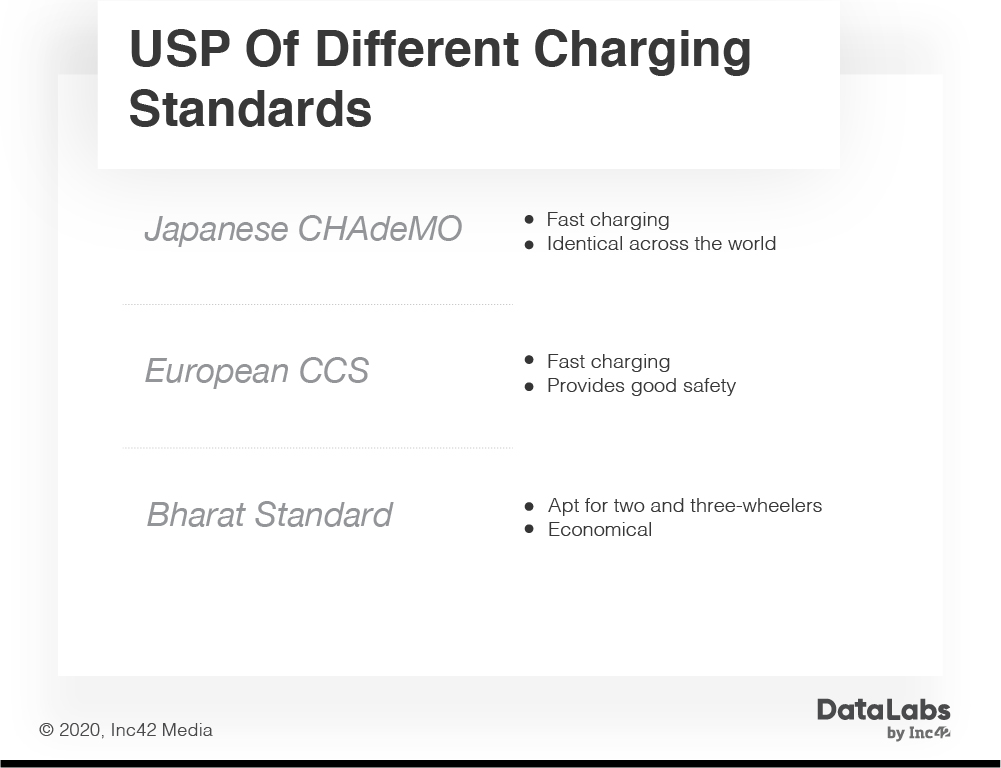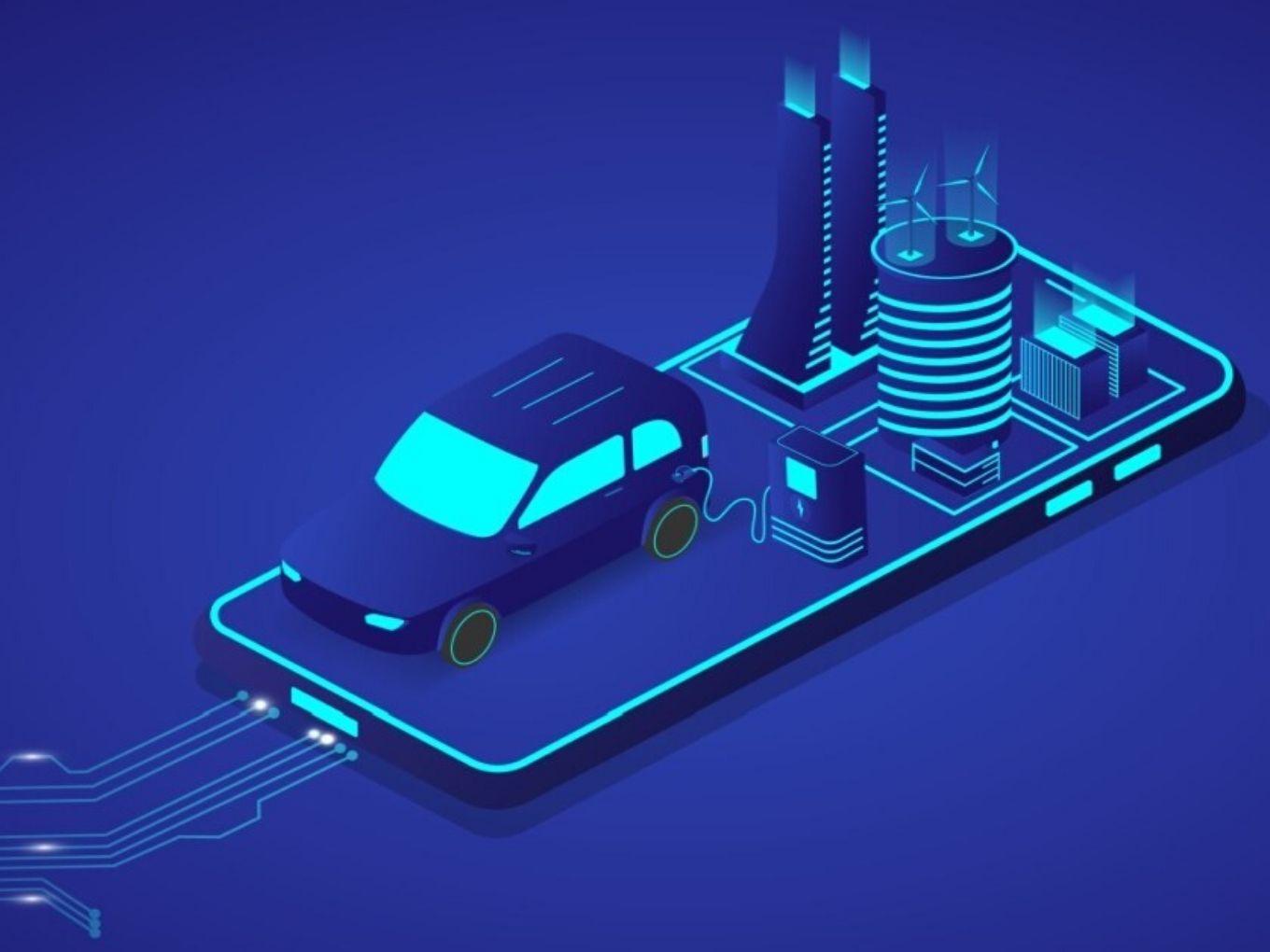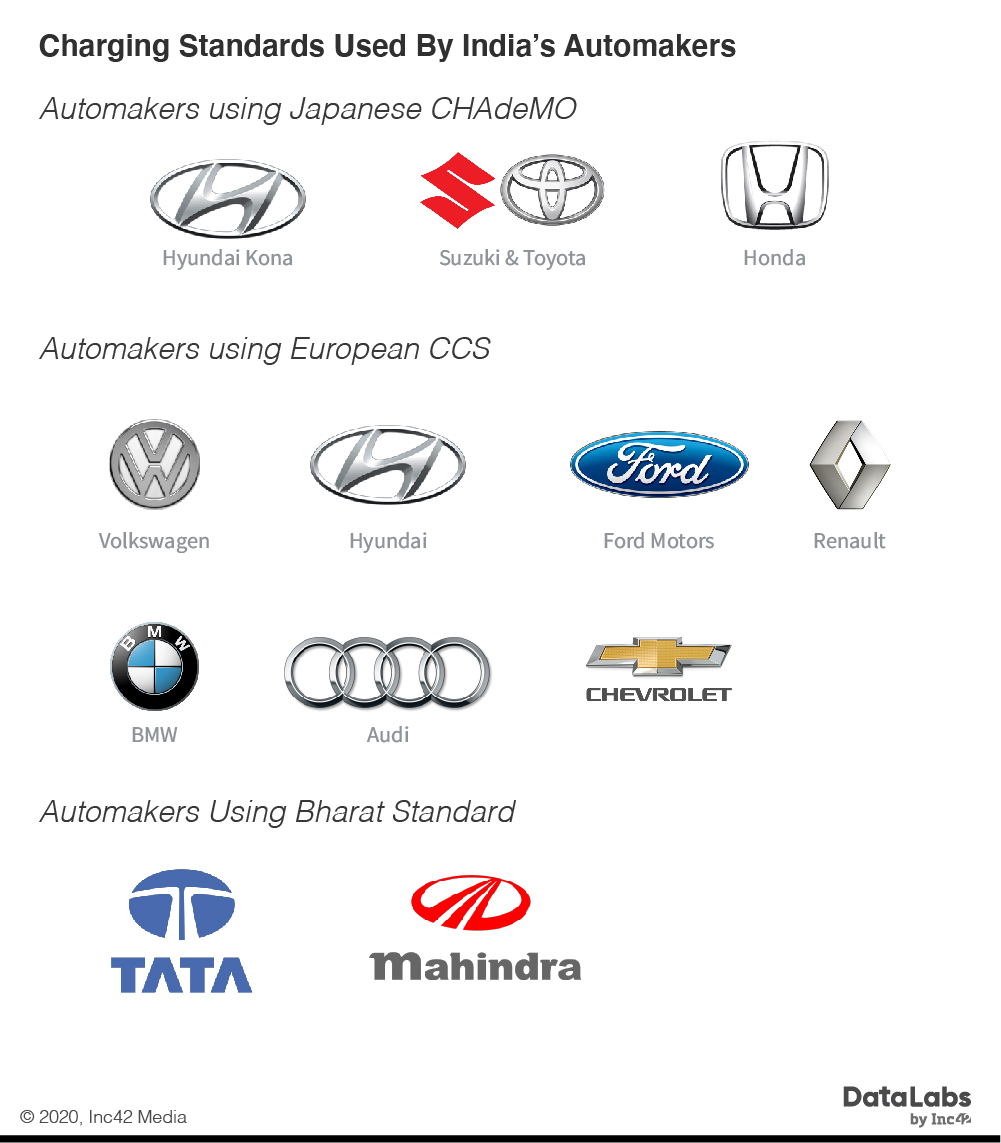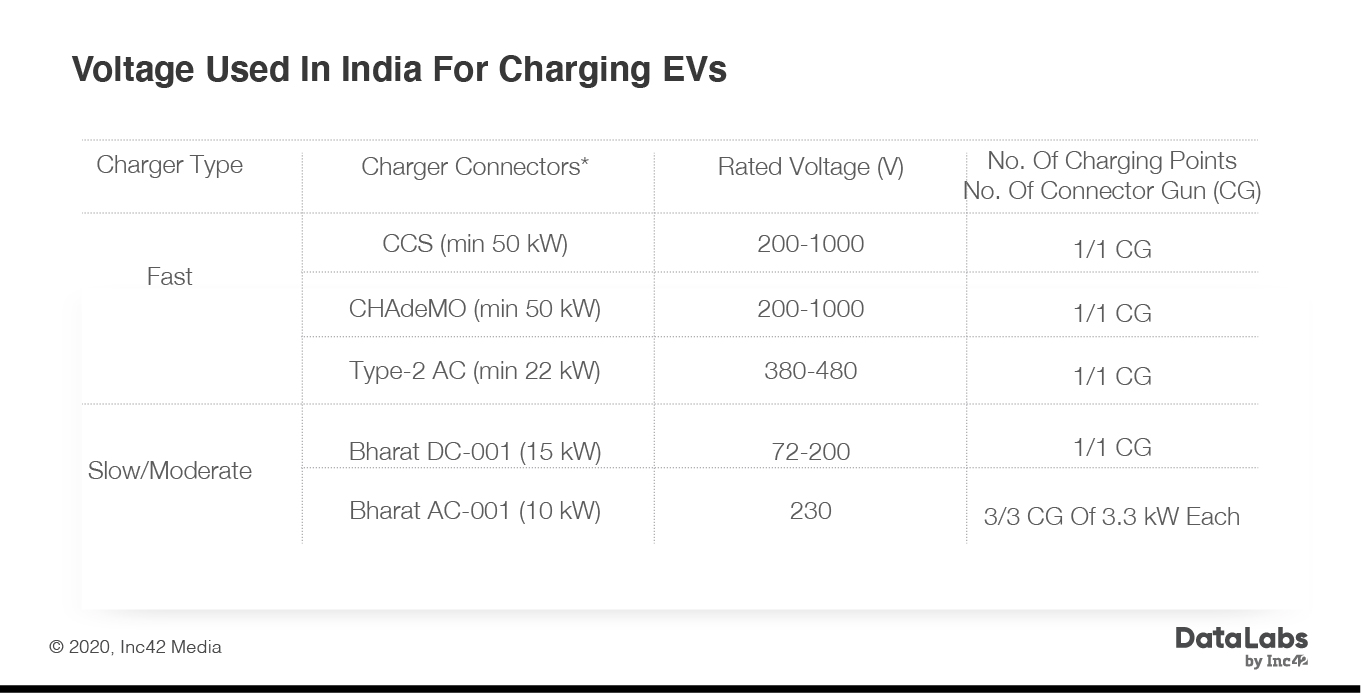Three competing charging standards — CHAdeMO, CCS and Indian Bharat Standard — are being used in India
The Bureau of Indian Standards (BIS) and the Department of Science and Technology (DST) are working towards standardising charging
Standardisation can reduce the cost of implementing EV charging stations, startups told Inc42
There is industry-wide consensus among electric vehicle companies and startups that one of the biggest problems in adoption of green mobility standards is the charging infrastructure. Simply put, India is not ready to support daily charging of millions of EVs and even where there is adequate charging infrastructure, the difference of opinion in selecting the right charging infrastructure standard for electric vehicles is one of the factors hindering widespread EV adoption.
While last year many media reports suggested that India was leaning towards the European charging infrastructure standards, this year speculation is rife about the ministry of power adopting all three charging standards currently followed by Indian automakers, namely Japanese CHAdeMO, European Combined Charging System (CCS) and the Indian Bharat Standard.
Leading automakers have been lobbying for the standards chosen by the electric cars and vehicles they make and understandably so, as they have already invested heavily in different technologies. But the fact is that setting up a charging station is currently expensive in India, because there are three globally accepted standards and companies based in India need to buy licenses from authorities in Japan or China or others.
The Bureau of Indian Standards (BIS) and the Department of Science and Technology (DST) are working towards standardising charging, which could reduce the cost of implementing EV charging stations. As per the Expression of Interest (EoI) application, an EV charging station has to have a set of electrical vehicle supply equipment (EVSE) satisfying the following requirements:
- Should be installed as per ministry of power notification dated December 14, 2018 titled ‘Charging infrastructure for Electric Vehicles – Guidelines and Standards’ and subsequent amendments thereof.
- Has to have associated up-stream electrical infrastructure required to supply electrical energy for the recharging of EVs.
- Should be equipped with advanced features like smart metering, cellular data capability and network connectivity.
The Three EV Charging Standards Adopted In India
Currently, the committee on standardization of protocol for EV charging has reportedly released recommendations with specifications for DC and AC charging for EVs. These are called – Bharat EV charger. Apart from this there are CHAdeMO and CCS standards of EV charging that are being adopted in new EV vehicles widely. Bharat EV is a low voltage charging technology while CHAdeMO and CCS are high voltage charging standards
“Talks are already ongoing in the industry around adoption of all three standards of charging for EVs- Japanese CHAdeMO, European Combined Charging System (CCS) and the Indian Bharat Standard. All three are fast charging technologies,” Jeetender Sharma, founder and managing director of Okinawa Autotech, told Inc42.

Japanese CHAdeMO EV Charging Tech
CHAdeMO protocol, which has been around for over ten years, is a DC charging standard for electric vehicles. It is developed by CHAdeMO Association, which also provides certification and ensures compatibility between the car and the charger.
CHAdeMO is smart grid-ready through its bi-directional charging capability and is also compatible with any local or optional functions beyond charging. CHAdeMO connector is identical across the globe and is a standalone plug that can be with or without an AC connector. This saves costs for EV makers and enables cross-continental EV travels.
The current is controlled by the vehicle’s electronic control unit. The output current is modulated according to the charging current request from the EV on a real-time basis. This means different fast-charging methods can be implemented based on battery performance and usage environment. To do so, CHAdeMO specifies the requirements for response performance, current ripple, voltage ripple, and measurement accuracy of the current and voltage. Toyota, Honda, Suzuki are the leading automakers using CHAdeMo capability.
European Combined Charging System (CCS) Tech
Hyundai Kona will be the first vehicle in the country that uses these fast chargers. In August this year Hyundai launched its full-electric SUV Kona in India priced at INR 25.3 lakh. The company plans to develop a mass-market EV for India to add to its newly launched full-electric SUV Kona. Combined Charging System is used by Volkswagen, Hyundai, Ford Motors, Renault, BMW, Chevrolet, Audi, Jeep, and Fiat. CCS was developed and endorsed by the Society of Automotive Engineers (SAE).
The CCS uses Combo 1 and Combo 2 connectors at up to 80 or 350 kilowatts. These two connectors are extensions of the Type 1 and Type 2 connectors, with two additional direct current (DC) contacts to allow high-power DC fast charging. The charging environment encompasses charging couplers, charging communication, charging stations, the electric vehicle and various functions for the charging process as e.g. load balancing and charge authorization.
There are around 7,000 CCS charging points worldwide with more than half in Europe. While the European Union considers CCS as the standard for fast-charging, it does not stop other plugs being installed.
Bharat Standard
Bharat Standard is a low voltage charging technology with an output of 72 volts–200 volts. Currently, it is used only to charge the Mahindra and Tata electric vehicles, namely TATA Tigor and Mahindra e-Verito and other vehicles built on those platforms in India. The Bharat Standard doesn’t apply to charging speeds above 15 kilowatts and is used to charge entry-level electric cars. DC-001 with voltage of 48V can also be used to charge advanced two-wheelers and three-wheelers.
This EV standard is the most economical of all the standards currently available globally and has been specifically created for the Indian market. Since it serves two and three-wheelers, it is considered the most apt for Indian audiences. It also offers lower upfront cost and higher market share.

Other Charging Standards And Tech
Besides these three standards, consumers have options such as the Tesla Supercharger, which compatible with Tesla only. It is a 480-volt DC fast-charging station built by Tesla for its electric cars. The Tesla Supercharger network of fast-charging stations was introduced in 2012. The network consists of more than 14,658 individual Superchargers at 1,659 locations globally. Reportedly, an additional 115 locations are under construction worldwide.
The Tesla Model S was the first car to use Supercharger, followed by the Tesla Model X and Tesla Model 3. Every charging stall has a connector to supply electrical power at up to 72‒250 kW o the 400-volt car battery pack.
Standardisation: The Need Of The Hour For Large-Scale EV Adoption
The country’s EV charging infrastructure is yet to be standardised and this presents a problem to companies and startups. EV charging station vendors are perplexed at the moment about the standard that should be adopted for fast charging. While the existing norms require charging stations to install Europe’s CCS and Japanese CHAdeMO charging platforms, setting up both will significantly increase the capital cost.
For the development of a proper EV ecosystem, it is critical that the charging infrastructure is standardised. Standardisation is mostly about the connector attached to the charging stations and the communication protocols used by charging stations to communicate with the vehicles. If standardisation is executed well, almost all EVs will be able to charge on any of the stations. They may require connector converters but this can be solved as seen in the US and EU.
“The government should ensure standardisation for the battery charging infrastructure and the battery swapping mechanism in order to create a uniform EV ecosystem. Local production of essential EV components is much needed in order to tackle the otherwise massive import costs,” Akhil Aryan, cofounder and CEO ION Energy told Inc42.
“For the same, the government needs to provide incentives for localized development and adoption of EVs,” he added. The government’s Faster Adoption and Manufacture Of Electric Vehicles scheme also known as FAME released in March 2015 aimed to incentivise and catalyse the electrification and allocated INR 895 Cr for the purpose. The policy triggered interest among startups and users.
The second phase of FAME, released in March 2019, has proposed to invest INR 10K Cr over three years to support 10 Lakh two-wheelers, 5 Lakh three-wheelers, 55K four-wheelers, and 7K buses that operate on lithium-ion batteries or other electric power-trains. FAME II linked demand incentive to battery capacity (kWh or kilowatt-hour) to establish the difference between an electric vehicle and an internal combustion engine. It also set a target for the number of vehicles that will be subsidised.
To meet these ambitious targets, the Indian government needs to speed up policy decisions on charging infrastructure standards.


































 Ad-lite browsing experience
Ad-lite browsing experience